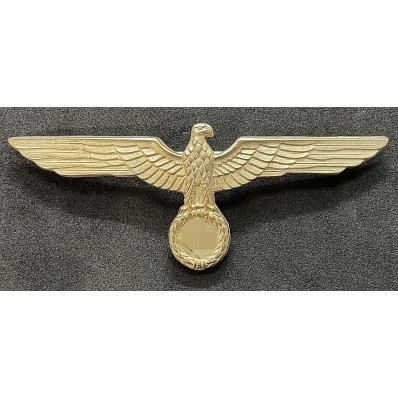No products
Product successfully added to your shopping cart
There are 0 items in your cart. There is 1 item in your cart.
Chest Eagle Kriegsmarine (Gold)
New
The Kriegsmarine (German pronunciation: [ˈkʁiːksmaˌʁiːnə], War Navy) was the navy of Nazi Germany from 1935 to 1945. It superseded the Imperial German Navy of the German Empire and the inter-war Reichsmarine.
- Satisfied or refunded: we guarantee 100% secure protection on your purchases
- Free return: return your order free of charge within 30 days from receipt
- Secure payments: pay securely online with PayPal or credit cards

More info
The Kriegsmarine (German pronunciation: [ˈkʁiːksmaˌʁiːnə], War Navy) was the navy of Nazi Germany from 1935 to 1945. It superseded the Imperial German Navy of the German Empire and the inter-war Reichsmarine. The Kriegsmarine was one of three official branches—along with the Heer (Army) and the Luftwaffe (Air Force)—of the Wehrmacht, the armed forces of Nazi Germany.
The Kriegsmarine grew rapidly during German naval rearmament in the 1930s (the Treaty of Versailles had limited the size of the German navy previously, and prohibited building of submarines). Kriegsmarine ships were deployed to the waters around Spain during the Spanish Civil War, under the guise of enforcing non-intervention, but in reality supporting the Franco side of the war.
In January 1939 Plan Z was ordered, calling for naval parity with the Royal Navy by 1944. However, when World War II broke out in September 1939, Plan Z was shelved in favour of building submarines (U-boats) and prioritizing land and air forces.
The Commander-in-Chief of the Kriegsmarine (as for all branches of armed forces during the period of absolute Nazi power) was Adolf Hitler, who exercised his authority through the Oberkommando der Marine.
The Kriegsmarine's most famous ships were the U-boats, most of which were constructed after Plan Z was abandoned at the beginning of World War II. Wolfpacks were rapidly assembled groups of submarines which attacked British convoys during the first half of the Battle of the Atlantic but this tactic was largely abandoned in the second half of the war. Along with the U-boats, surface commerce raiders (including auxiliary cruisers) were used to disrupt Allied shipping in the early years of the war, the most famous of these being the heavy cruisers Admiral Graf Spee and Admiral Scheer and the battleship Bismarck. However, the adoption of convoy escorts, especially in the Atlantic, greatly reduced the effectiveness of commerce raiders against convoys.
After the Second World War, the Kriegsmarine's remaining ships were divided up amongst the Allied powers and were used for various purposes including minesweeping.
Kriegsmarine
- Germany
- Medals, Orders and Decorations
- Badges and Pins
- ID Tags
- Arm Shields
- Visor Caps and Hats
- Cap and Helmet Badges
- Collar Tabs Cyphers
- Collar Tabs, Shoulder Boards and Epaulettes
- Arm Bands
- Division Cuff Titles
- Buckles And Belts
- Buttons For Uniforms
- Stamps
- Gorgets
- Rings
- SS Honour Ring in 925 Silver - Collector's Set
- Poletops
- Flags
- Daggers and Knives (Ornamental)
- Field Marshal Batons
- Ammo Pouches, Bandoliers and Bags
- Service Watches
- Presentation Cases
- Documents and Award Letters
- Busts, Eagles, Lighters and Miscellaneous
- Croatian and Ustasha Militaria
- Denazified Articles
- Commemorative Necklaces
- Spare Parts, Small Parts and Accessories
- Italy
- Medals and Decorations
- Brevets And Badges
- Battle Shields and Tags
- Gorgets
- Visor Caps and Hats
- Cap and Helmet Badges
- Friezes for Collar Tabs
- Collar Tabs, Shoulder Boards and Epaulettes
- Buckles
- Belts
- Buttons For Uniforms
- Rings
- Poletops
- Italian Resistance
- Keyrings
- Wallshields
- Daggers and Knives
- Flags
- Busts and Eagles
- Souvenirs
- Commemorative Necklaces
- Imperial Germany
- Soviet Union
- Other Countries






